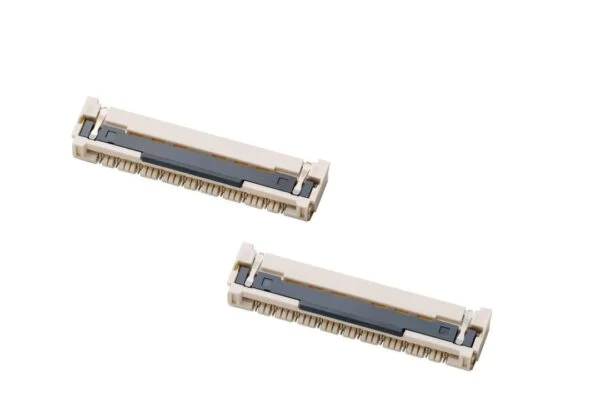Kyocera has launched a series of connectors for flexible printed circuit board (FPC) and flexible flat cable (FFC) with 0.5mm-pitch one-action locking.
The 6893 Series has twice the foreign matter removal performance compared to the previous generation connectors to help prevent the FPC/FFC deposits that can cause contact failure after insertion. The connectors are heat-resistant up to 125 degrees Celsius and mountable on in-vehicle devices such as HUDs, clusters, and CIDs with strict high-temperature compliance.
With the rapidly growing EV market, one-action lock type FPC/FFC connector technology has expanded into onboard electronics for electric vehicles as well.
In principle, the essential features of one-action lock-type connectors include labour savings through the automation of FPC/FFC insertion. However, in practice, foreign matter adhering to the FPC/FFC can cause contact failure, creating an obstacle to full automation.

In conventional FPC/FFC connectors, the pin and the FPC/FFC make contact at a single point during insertion to remove foreign matter adhering to the FPC/FFC. Kyocera’s 6893 Series connectors achieve twice the foreign matter removal performance of previous Kyocera models by using our proprietary and patented contact pin structure, which provides two contact points in the same direction as the insertion point. With this structure, our new product ensures a superior electrical connection and reduces contact failure rates.
A typical FPC/FFC connector requires three assembly actions: (1) opening the lock, (2) inserting the FPC/FFC, and (3) closing the lock. For Kyocera’s 6893 Series, the locking section structure has been drastically revised to allow the connector side protrusion that fits into the FPC/FFC to lock automatically when you insert FPC/FFC. This structure enables the FPC/FFC to be locked in a single operation (one action) by inserting the FPC/FFC, reducing assembly labour by two-thirds. Kyocera’s 6893 Series also supports automated assembly by robots.
Kyocera will continue to expand its connector line, including FPC/FFC connectors.



Leave a comment